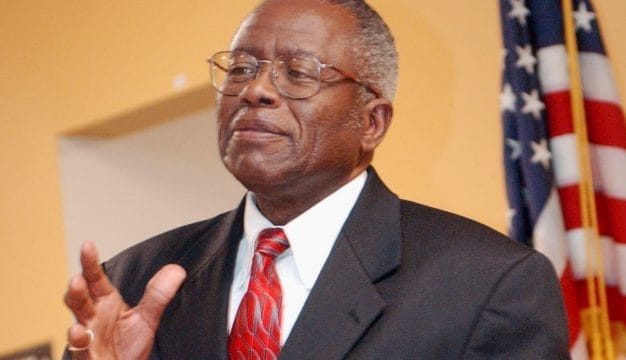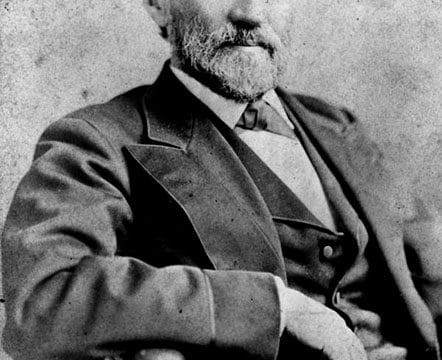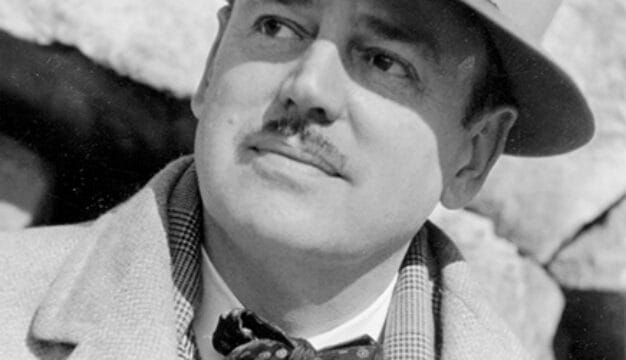Lake Martin and Thomas Wesley Martin Dam
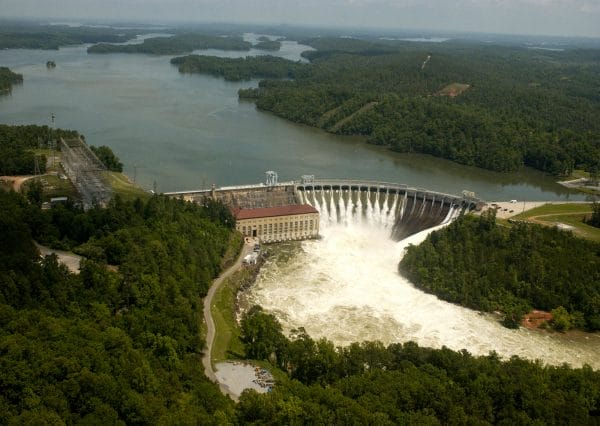 Martin Lake and Dam
Created by the construction of the Thomas Wesley Martin Dam, Lake Martin (not to be confused with Logan Martin Lake) on the Tallapoosa River covers approximately 40,000 acres when the reservoir is full and has more than 700 miles of shoreline, making it one of the largest manmade lakes in Alabama. At the time of its construction, it was the largest manmade lake in the world. The Thomas Wesley Martin Dam, which stopped the flow of the Tallapoosa River just southwest of Dadeville, is one of several built on the Tallapoosa during the first half of the twentieth century. The dam and lake are important economic and recreational centers for the state, providing boating, fishing, and other opportunities to visitors and 154,200 kilowatts of hydroelectric power.
Martin Lake and Dam
Created by the construction of the Thomas Wesley Martin Dam, Lake Martin (not to be confused with Logan Martin Lake) on the Tallapoosa River covers approximately 40,000 acres when the reservoir is full and has more than 700 miles of shoreline, making it one of the largest manmade lakes in Alabama. At the time of its construction, it was the largest manmade lake in the world. The Thomas Wesley Martin Dam, which stopped the flow of the Tallapoosa River just southwest of Dadeville, is one of several built on the Tallapoosa during the first half of the twentieth century. The dam and lake are important economic and recreational centers for the state, providing boating, fishing, and other opportunities to visitors and 154,200 kilowatts of hydroelectric power.
In the early twentieth century, the Tallapoosa River flowed through Cherokee Bluffs, a deep gorge with high rock cliffs on both sides that was a popular picnicking area. The river is the dividing line between Tallapoosa and Elmore counties. As early as 1916, Alabama Power Company began acquiring options and purchasing land to be flooded, and many families had left the area long before the company completed the 168-foot high dam that stretched 2,000 feet across the Tallapoosa River gorge at Cherokee Bluffs. The communities of Susanna (Sousanna) and Benson, including several houses and churches, were razed, and the company relocated 12 cemeteries containing 923 graves.
Land clearing began in July 1923, and tracks were laid from the nearest railhead at Kent so supplies could reach the isolated construction site. Through its construction company, Dixie Construction, Alabama Power built a complete village for workers, including housing, a mess hall, a commissary, a recreation hall, and a hospital. The dam included 431,000 yards of concrete and was completed and the gates closed in 1926; however, the lake did not fill completely until heavy rains on April 23, 1928, forced the company to open several of the 20 floodgates for the first time. The total floodgate capacity is 3,016,000 gallons per minute. In 1926 the dam was named for Alabama Power president Thomas Wesley Martin but was not dedicated officially until 1936.
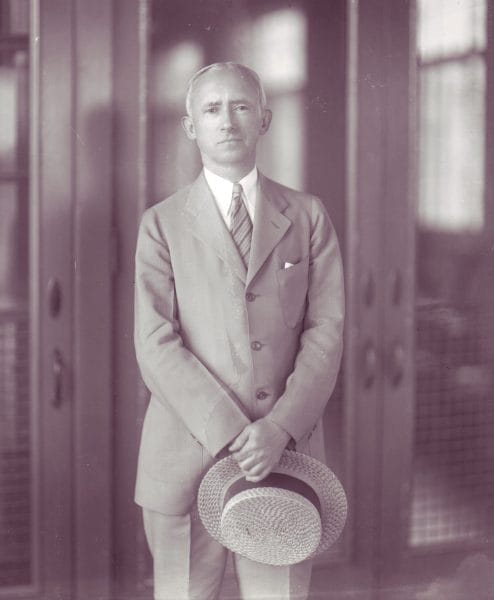 Thomas W. Martin
The water depth at the dam is 155 feet and the highest operating head (the difference between the top of the pool above the dam and the top of the pool below the dam) is 150 feet. Three generators were operational beginning in 1926, with a fourth added in 1952. In 2007 the dam’s four generating units had a capacity of 154,200 kilowatts. The amount of electricity that can be generated by hydropower is limited by the amount of water available, and generators typically operate only 25 percent of the time. Based on an average household using 1,000 kilowatts a month, the dam provides electricity to about 28,000 homes at any given time. In normal operation, the four generators pass a total of 16,440 cubic feet of water per second.
Thomas W. Martin
The water depth at the dam is 155 feet and the highest operating head (the difference between the top of the pool above the dam and the top of the pool below the dam) is 150 feet. Three generators were operational beginning in 1926, with a fourth added in 1952. In 2007 the dam’s four generating units had a capacity of 154,200 kilowatts. The amount of electricity that can be generated by hydropower is limited by the amount of water available, and generators typically operate only 25 percent of the time. Based on an average household using 1,000 kilowatts a month, the dam provides electricity to about 28,000 homes at any given time. In normal operation, the four generators pass a total of 16,440 cubic feet of water per second.
Lake Martin is fed by a watershed that encompasses 3,000 square miles in east-central Alabama at the end of the southern Piedmont Upland physiographic section. Kowaliga Creek, Big and Little Sandy Creeks, and Blue Creek join the Tallapoosa River north of the dam and are important tributaries. The lake is 490 feet above sea level at full capacity, but its level fluctuates to accommodate seasonal rainfall and to maintain hydroelectric power generation in the dry season. Lake Martin is crossed by the Central of Georgia railroad bridge to the north and by three vehicular bridges, including a four-lane bridge on U.S. Highway 280 east of Alexander City. Bridges also cross Kowaliga Creek and Blue Creek. Kowaliga, a Creek Indian name, was made famous by Alabama country music star Hank Williams Sr. in his song “Kaw-Liga,” about the legend of a wooden Indian statue. Shortly after Williams’ death in 1953, a wooden Indian was placed at the fish camp and café on the south side of the Kowaliga Creek Bridge, a place Williams knew well and often visited.
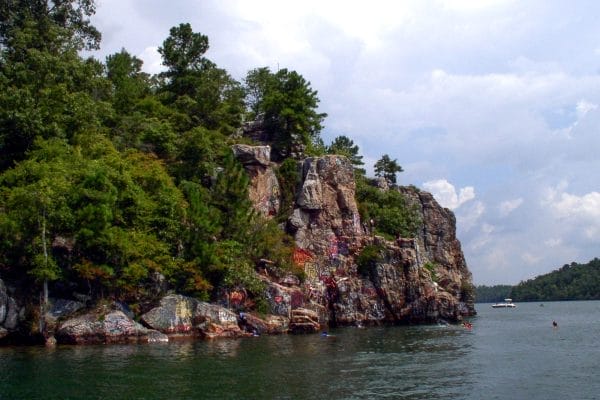 Chimney Rock
Long called the “pearl of Alabama” by sportsmen, the lake attracts fishermen, water skiers, boating enthusiasts, and campers to its shores and private homes. The two largest owners of lakefront property are Alabama Power and Russell Lands, owned by the descendants of Benjamin Russell, who founded apparel manufacturer Russell Mills in Alexander City. Two recreational facilities, Wind Creek State Park and D.A.R.E. Power Park, are open to the public, along with numerous state boat ramps. Chimney Rock Island and Acapulco Rock (often called Chimney Rock) are popular landmarks, along with the recently constructed lighthouse at Children’s Harbor. Two golf courses, Willow Point Golf and Country Club and Still Waters, are located on points along the shoreline. Most of the recent Alabama governors have had summer homes on Lake Martin, and in the 1950s one large bay was the site of cottages of both the presidents and the head football coaches of the University of Alabama and Auburn University. In fact, the area witnessed so much revelry that the name “Cocktail Slough” has endured. Many Alabama political alliances, business deals, and romances have by myth and legend been consummated at Lake Martin, one of the state’s finest assets.
Chimney Rock
Long called the “pearl of Alabama” by sportsmen, the lake attracts fishermen, water skiers, boating enthusiasts, and campers to its shores and private homes. The two largest owners of lakefront property are Alabama Power and Russell Lands, owned by the descendants of Benjamin Russell, who founded apparel manufacturer Russell Mills in Alexander City. Two recreational facilities, Wind Creek State Park and D.A.R.E. Power Park, are open to the public, along with numerous state boat ramps. Chimney Rock Island and Acapulco Rock (often called Chimney Rock) are popular landmarks, along with the recently constructed lighthouse at Children’s Harbor. Two golf courses, Willow Point Golf and Country Club and Still Waters, are located on points along the shoreline. Most of the recent Alabama governors have had summer homes on Lake Martin, and in the 1950s one large bay was the site of cottages of both the presidents and the head football coaches of the University of Alabama and Auburn University. In fact, the area witnessed so much revelry that the name “Cocktail Slough” has endured. Many Alabama political alliances, business deals, and romances have by myth and legend been consummated at Lake Martin, one of the state’s finest assets.
Further Reading
- Atkins, Leah Rawls. Developed for the Service of Alabama: The Centennial History of the Alabama Power Company, 1906-2006. Birmingham: Alabama Power Company, 2006.
- Jackson, Harvey H., III. Putting “Loafing Streams” to Work: The Building of Lay, Mitchell, Martin, and Jordan Dams, 1910-1929. Tuscaloosa: University of Alabama Press, 1997.
- Schafer, Elizabeth D. Lake Martin: Alabama’s Crown Jewel. Charleston, S.C.: Arcadia Press, 2003.
